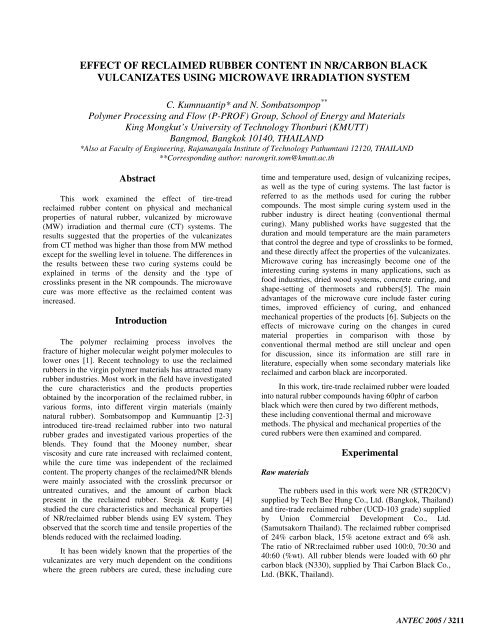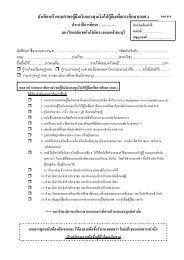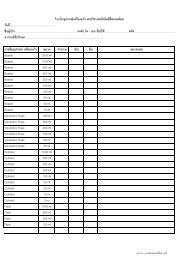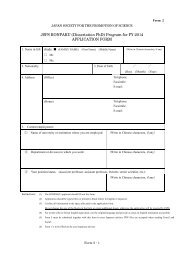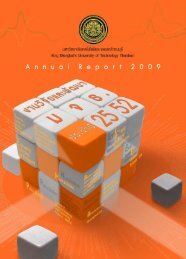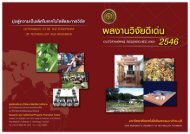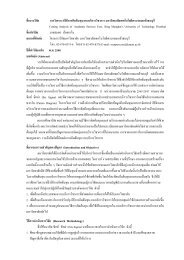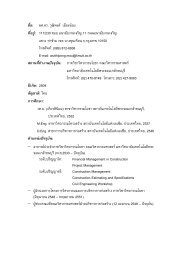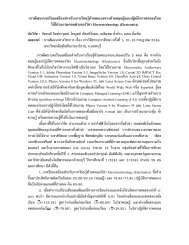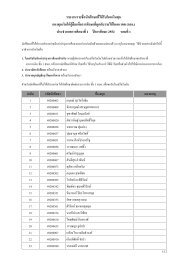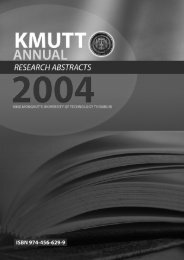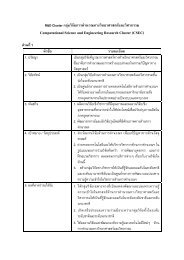Effect of Reclaimed Rubber Content in NR/Carbon Black ... - kmutt
Effect of Reclaimed Rubber Content in NR/Carbon Black ... - kmutt
Effect of Reclaimed Rubber Content in NR/Carbon Black ... - kmutt
You also want an ePaper? Increase the reach of your titles
YUMPU automatically turns print PDFs into web optimized ePapers that Google loves.
EFFECT OF RECLAIMED RUBBER CONTENT IN <strong>NR</strong>/CARBON BLACK<br />
VULCANIZATES USING MICROWAVE IRRADIATION SYSTEM<br />
C. Kumnuantip* and N. Sombatsompop **<br />
Polymer Process<strong>in</strong>g and Flow (P-PROF) Group, School <strong>of</strong> Energy and Materials<br />
K<strong>in</strong>g Mongkut’s University <strong>of</strong> Technology Thonburi (KMUTT)<br />
Bangmod, Bangkok 10140, THAILAND<br />
*Also at Faculty <strong>of</strong> Eng<strong>in</strong>eer<strong>in</strong>g, Rajamangala Institute <strong>of</strong> Technology Pathumtani 12120, THAILAND<br />
**Correspond<strong>in</strong>g author: narongrit.som@<strong>kmutt</strong>.ac.th<br />
Abstract<br />
This work exam<strong>in</strong>ed the effect <strong>of</strong> tire-tread<br />
reclaimed rubber content on physical and mechanical<br />
properties <strong>of</strong> natural rubber, vulcanized by microwave<br />
(MW) irradiation and thermal cure (CT) systems. The<br />
results suggested that the properties <strong>of</strong> the vulcanizates<br />
from CT method was higher than those from MW method<br />
except for the swell<strong>in</strong>g level <strong>in</strong> toluene. The differences <strong>in</strong><br />
the results between these two cur<strong>in</strong>g systems could be<br />
expla<strong>in</strong>ed <strong>in</strong> terms <strong>of</strong> the density and the type <strong>of</strong><br />
crossl<strong>in</strong>ks present <strong>in</strong> the <strong>NR</strong> compounds. The microwave<br />
cure was more effective as the reclaimed content was<br />
<strong>in</strong>creased.<br />
Introduction<br />
The polymer reclaim<strong>in</strong>g process <strong>in</strong>volves the<br />
fracture <strong>of</strong> higher molecular weight polymer molecules to<br />
lower ones [1]. Recent technology to use the reclaimed<br />
rubbers <strong>in</strong> the virg<strong>in</strong> polymer materials has attracted many<br />
rubber <strong>in</strong>dustries. Most work <strong>in</strong> the field have <strong>in</strong>vestigated<br />
the cure characteristics and the products properties<br />
obta<strong>in</strong>ed by the <strong>in</strong>corporation <strong>of</strong> the reclaimed rubber, <strong>in</strong><br />
various forms, <strong>in</strong>to different virg<strong>in</strong> materials (ma<strong>in</strong>ly<br />
natural rubber). Sombatsompop and Kumnuantip [2-3]<br />
<strong>in</strong>troduced tire-tread reclaimed rubber <strong>in</strong>to two natural<br />
rubber grades and <strong>in</strong>vestigated various properties <strong>of</strong> the<br />
blends. They found that the Mooney number, shear<br />
viscosity and cure rate <strong>in</strong>creased with reclaimed content,<br />
while the cure time was <strong>in</strong>dependent <strong>of</strong> the reclaimed<br />
content. The property changes <strong>of</strong> the reclaimed/<strong>NR</strong> blends<br />
were ma<strong>in</strong>ly associated with the crossl<strong>in</strong>k precursor or<br />
untreated curatives, and the amount <strong>of</strong> carbon black<br />
present <strong>in</strong> the reclaimed rubber. Sreeja & Kutty [4]<br />
studied the cure characteristics and mechanical properties<br />
<strong>of</strong> <strong>NR</strong>/reclaimed rubber blends us<strong>in</strong>g EV system. They<br />
observed that the scorch time and tensile properties <strong>of</strong> the<br />
blends reduced with the reclaimed load<strong>in</strong>g.<br />
It has been widely known that the properties <strong>of</strong> the<br />
vulcanizates are very much dependent on the conditions<br />
where the green rubbers are cured, these <strong>in</strong>clud<strong>in</strong>g cure<br />
time and temperature used, design <strong>of</strong> vulcaniz<strong>in</strong>g recipes,<br />
as well as the type <strong>of</strong> cur<strong>in</strong>g systems. The last factor is<br />
referred to as the methods used for cur<strong>in</strong>g the rubber<br />
compounds. The most simple cur<strong>in</strong>g system used <strong>in</strong> the<br />
rubber <strong>in</strong>dustry is direct heat<strong>in</strong>g (conventional thermal<br />
cur<strong>in</strong>g). Many published works have suggested that the<br />
duration and mould temperature are the ma<strong>in</strong> parameters<br />
that control the degree and type <strong>of</strong> crossl<strong>in</strong>ks to be formed,<br />
and these directly affect the properties <strong>of</strong> the vulcanizates.<br />
Microwave cur<strong>in</strong>g has <strong>in</strong>creas<strong>in</strong>gly become one <strong>of</strong> the<br />
<strong>in</strong>terest<strong>in</strong>g cur<strong>in</strong>g systems <strong>in</strong> many applications, such as<br />
food <strong>in</strong>dustries, dried wood systems, concrete cur<strong>in</strong>g, and<br />
shape-sett<strong>in</strong>g <strong>of</strong> thermosets and rubbers[5]. The ma<strong>in</strong><br />
advantages <strong>of</strong> the microwave cure <strong>in</strong>clude faster cur<strong>in</strong>g<br />
times, improved efficiency <strong>of</strong> cur<strong>in</strong>g, and enhanced<br />
mechanical properties <strong>of</strong> the products [6]. Subjects on the<br />
effects <strong>of</strong> microwave cur<strong>in</strong>g on the changes <strong>in</strong> cured<br />
material properties <strong>in</strong> comparison with those by<br />
conventional thermal method are still unclear and open<br />
for discussion, s<strong>in</strong>ce its <strong>in</strong>formation are still rare <strong>in</strong><br />
literature, especially when some secondary materials like<br />
reclaimed and carbon black are <strong>in</strong>corporated.<br />
In this work, tire-trade reclaimed rubber were loaded<br />
<strong>in</strong>to natural rubber compounds hav<strong>in</strong>g 60phr <strong>of</strong> carbon<br />
black which were then cured by two different methods,<br />
these <strong>in</strong>clud<strong>in</strong>g conventional thermal and microwave<br />
methods. The physical and mechanical properties <strong>of</strong> the<br />
cured rubbers were then exam<strong>in</strong>ed and compared.<br />
Raw materials<br />
Experimental<br />
The rubbers used <strong>in</strong> this work were <strong>NR</strong> (STR20CV)<br />
supplied by Tech Bee Hung Co., Ltd. (Bangkok, Thailand)<br />
and tire-trade reclaimed rubber (UCD-103 grade) supplied<br />
by Union Commercial Development Co., Ltd.<br />
(Samutsakorn Thailand). The reclaimed rubber comprised<br />
<strong>of</strong> 24% carbon black, 15% acetone extract and 6% ash.<br />
The ratio <strong>of</strong> <strong>NR</strong>:reclaimed rubber used 100:0, 70:30 and<br />
40:60 (%wt). All rubber blends were loaded with 60 phr<br />
carbon black (N330), supplied by Thai <strong>Carbon</strong> <strong>Black</strong> Co.,<br />
Ltd. (BKK, Thailand).
<strong>Rubber</strong> sample preparation<br />
The formulation <strong>of</strong> the rubber compounds was as<br />
follows: 100 phr rubber blended (<strong>NR</strong> : reclaimed rubber ;<br />
100:0, 70:30 and 40:60 by weight), 60 phr carbon black,<br />
5.0 phr z<strong>in</strong>c oxide (ZnO), 2.0 phr stearic acid, 0.5 phr<br />
mercaptobenzthiazole (MBT), 0.2 phr diphenylguanid<strong>in</strong>e<br />
(DPG), and 3.0 phr sulfur. In the mastication step, the<br />
natural rubber was masticated on a laboratory two-roll<br />
mill (Yong Fong Mach<strong>in</strong>ery Co., Ltd., Samutsakon,<br />
Thailand) for 5 m<strong>in</strong> and was then blended with the tiretrade<br />
reclaimed rubber for another 5 m<strong>in</strong>utes. In the<br />
compound<strong>in</strong>g step, the rubber and filler were<br />
compounded with prepared vulcanization chemicals on<br />
the two-roll mill for another 10 m<strong>in</strong>, and the compounds<br />
were then kept at 25 o C at 50% humidity before further use.<br />
Design and construction <strong>of</strong> microwave apparatus<br />
The microwave vulcanization oven consisted <strong>of</strong><br />
three magnetrons, each magnetron giv<strong>in</strong>g microwave<br />
power 1,000 watt. Three waveguides <strong>in</strong> rectangular shape<br />
used were 90mm wide, 80mm deep and 40mm high. The<br />
microwave oven body was made from sta<strong>in</strong>less steel<br />
whose cavity size had 30 cm high, 40 cm wide and 50 mm<br />
long. The mould used was made <strong>of</strong> Teflon and it can<br />
produce vulcanized rubber sheet <strong>of</strong> 2mm thick.<br />
Vulcanization methods <strong>of</strong> rubber blends<br />
For conventional thermal (CT) cur<strong>in</strong>g: The resultant<br />
rubber compound was compression-molded us<strong>in</strong>g a<br />
hydraulic press (LAB TECH Co., Ltd., Bangkok,<br />
Thailand) at 170 kg/cm 2 . For comparison purposes,the<br />
cure time was fixed at 3 m<strong>in</strong>utes for all rubber compounds.<br />
The cure temperatures used were 145 o C for <strong>NR</strong><br />
compounds, and 150 o C for <strong>NR</strong> with reclaimed rubber.<br />
For microwave (MW) cur<strong>in</strong>g: The resultant rubber<br />
compound was placed <strong>in</strong> the microwave apparatus. The<br />
temperature <strong>of</strong> the vulcanizates was determ<strong>in</strong>ed by<br />
immediately measur<strong>in</strong>g it after stopp<strong>in</strong>g the microwave<br />
irradiation us<strong>in</strong>g a IR probe. The cure temperatures used<br />
for this method was the same as used <strong>in</strong> the CT method<br />
for any given reclaimed contents (145 o C for the<br />
compounds with no reclaimed rubber and 150 o C for those<br />
with reclaimed rubber). By trial and error experiment, the<br />
cure time used for MW method was 3 m<strong>in</strong>utes, above this<br />
value caus<strong>in</strong>g an over-cur<strong>in</strong>g <strong>of</strong> the rubber compounds.<br />
Characterization<br />
Physical properties: The physical properties <strong>of</strong> the<br />
vulcanizates were carried out through sorption-desorption<br />
behavior and crossl<strong>in</strong>k density determ<strong>in</strong>ation. The<br />
sorption method is referred to as the amount <strong>of</strong> toluene<br />
uptake (or release), whose experimental procedure can be<br />
found elsewhere [3]. The crossl<strong>in</strong>k density determ<strong>in</strong>ation<br />
was achieved by use <strong>of</strong> the Flory-Rehner equation, whose<br />
experimental details can be obta<strong>in</strong>ed elsewhere [2].<br />
Mechanical properties: Various mechanical<br />
property evaluations were performed. The tensile<br />
properties (modulus at 100% elongation, ultimate tensile<br />
stress, and %elongation at break) <strong>of</strong> the vulcanizates were<br />
tested accord<strong>in</strong>g to ASTM D 412-92 (1998); the tests<br />
be<strong>in</strong>g carried out with a universal test<strong>in</strong>g mach<strong>in</strong>e<br />
(Autograph AG-I, Shimadzu, Tokyo, Japan). Tear<br />
strength was determ<strong>in</strong>ed specified by ASTM D 624-<br />
00(2000) us<strong>in</strong>g angle-shaped samples and a Shimadzu<br />
tear strength test<strong>in</strong>g mach<strong>in</strong>e. The test<strong>in</strong>g speeds for<br />
tensile and tear properties were 500 mm/m<strong>in</strong>. Vulcanizate<br />
hardness was carried out us<strong>in</strong>g Shore A Instrument &<br />
M.F.G., model PN71500 by ASTM D 2240-97 (1997).<br />
Results and discussion<br />
Figure 1 shows the effect <strong>of</strong> reclaimed rubber<br />
content on crossl<strong>in</strong>k density <strong>of</strong> the <strong>NR</strong>/CB vulcanizates<br />
cured by conventional thermal (CT) and microwave (MW)<br />
methods. It can be observed that the addition <strong>of</strong> reclaimed<br />
rubber had a significant effect on the crossl<strong>in</strong>k density for<br />
both cur<strong>in</strong>g systems. The crossl<strong>in</strong>k density greatly<br />
<strong>in</strong>creased with reclaimed rubber content. This was<br />
because load<strong>in</strong>g the reclaimed rubber <strong>in</strong>to the <strong>NR</strong>/CB<br />
compounds would automatically <strong>in</strong>crease the carbon<br />
black contents <strong>in</strong>to the rubbers [2]. It is widely evidenced<br />
that carbon black can perform as a physical crossl<strong>in</strong>ker <strong>in</strong><br />
the rubber matrix as a result <strong>of</strong> the rubber molecules be<strong>in</strong>g<br />
absorbed <strong>in</strong>to the black surface dur<strong>in</strong>g compound<strong>in</strong>g [7-8].<br />
The detail <strong>of</strong> the rubber-carbon black <strong>in</strong>teraction can be<br />
found elsewhere [9]. Consider<strong>in</strong>g the effect <strong>of</strong> cur<strong>in</strong>g type,<br />
it was found that the MW method gave a slightly lower<br />
crossl<strong>in</strong>k density than the CT method. The effect <strong>of</strong><br />
reclaimed rubber content on the change <strong>in</strong> crossl<strong>in</strong>k<br />
density <strong>in</strong> the MW method was similar to that <strong>in</strong> the CT<br />
method, this <strong>in</strong>dicat<strong>in</strong>g that the crossl<strong>in</strong>k<strong>in</strong>g reaction as a<br />
result <strong>of</strong> reclaimed rubber load<strong>in</strong>g, which had occurred <strong>in</strong><br />
these two cur<strong>in</strong>g methods were the same.<br />
Although the chemically crossl<strong>in</strong>k<strong>in</strong>g reactions <strong>of</strong><br />
the rubbers from these two cur<strong>in</strong>g methods were the same<br />
as stated <strong>in</strong> the explanation given for Figure 1, their<br />
mechanisms <strong>of</strong> the heat generation and its transfer to the<br />
rubber were probably different. In CT method, the heat<br />
was generated by external heat<strong>in</strong>g system and was<br />
transferred as a result <strong>of</strong> the thermal conduction from the<br />
mould to the rubber compound where the cross-l<strong>in</strong>k<strong>in</strong>g<br />
process took place. It was predictable that, dur<strong>in</strong>g<br />
compression mould<strong>in</strong>g, temperatures across the thickness<br />
<strong>of</strong> the vulcanized sheet were not uniform, and this would<br />
lead to differences <strong>in</strong> cure times across the sheet thickness.<br />
For MW method, the temperatures across the sheet<br />
thickness were thought to be the same s<strong>in</strong>ce the heat was<br />
generated simultaneously throughout the rubber sheet<br />
dur<strong>in</strong>g the cur<strong>in</strong>g. The mechanism <strong>of</strong> the rubber cur<strong>in</strong>g by<br />
microwave <strong>in</strong>volves changes <strong>in</strong> polarization <strong>of</strong> the
materials caused by microwave absorption. When the<br />
microwave passed <strong>in</strong>to the rubber compounds (now<br />
regarded as absorber material), the electric field would<br />
occur <strong>in</strong>side the compounds as a result <strong>of</strong> microwave<br />
absorption. This electric field activated the changes <strong>in</strong><br />
motions (rotations and vibrations) and polarizations <strong>of</strong> the<br />
rubber molecules, which then caused molecular frictions<br />
and the heat <strong>in</strong> the rubber compound, the cur<strong>in</strong>g be<strong>in</strong>g<br />
then <strong>in</strong>itiated [10-11]. It should also be noted that the<br />
presence <strong>of</strong> carbon black was necessary when cur<strong>in</strong>g by<br />
microwave s<strong>in</strong>ce the natural rubber itself is a low<br />
dielectric loss material that does not react with microwave<br />
[10]. In order to achieve the cur<strong>in</strong>g, carbon black needs to<br />
be added because carbon black has a relatively high<br />
dielectric loss, and this will <strong>in</strong>crease the dielectric loss<br />
property <strong>of</strong> the blend and thus be <strong>in</strong>duced by microwave<br />
irradiation [10].<br />
Figure 2 illustrates the sorption-desorption behavior<br />
<strong>of</strong> the <strong>NR</strong>/CB vulcanizates <strong>in</strong> toluene as a function <strong>of</strong><br />
reclaimed rubber content for CT and MW cur<strong>in</strong>g methods.<br />
It was found that the higher reclaimed rubber content the<br />
lower the toluene uptake. This was expected because the<br />
decrease <strong>in</strong> toluene uptake was caused by the <strong>in</strong>crease <strong>in</strong><br />
crossl<strong>in</strong>k density as a result <strong>of</strong> the carbon black <strong>in</strong> the<br />
reclaim. The <strong>in</strong>creased crossl<strong>in</strong>ks resulted <strong>in</strong> a restriction<br />
<strong>in</strong> mobility <strong>of</strong> rubber molecules which prevented the<br />
penetration <strong>of</strong> the solvent molecules <strong>in</strong>to the rubber [3,12].<br />
Compar<strong>in</strong>g the sorption behaviour <strong>of</strong> the vulcanizates<br />
from two different cur<strong>in</strong>g systems, it was found that the<br />
rate and the mole% uptake (or release) <strong>of</strong> toluene <strong>in</strong><br />
vulcanizates for CT method were greater up to 600<br />
m<strong>in</strong>utes, and after than, the mole% uptake <strong>of</strong> toluene <strong>in</strong><br />
the vulcanizates for CT method was lower.<br />
In this prelim<strong>in</strong>ary study, s<strong>in</strong>ce the heat<strong>in</strong>g<br />
mechanisms between the CT and MW methods were<br />
different the types <strong>of</strong> crossl<strong>in</strong>ks formed <strong>in</strong> the rubber<br />
compounds would probably be different. It was postulated<br />
that the crossl<strong>in</strong>k types <strong>in</strong> the vulcanizates cured by CT<br />
method tended to be more polysulfides while those by<br />
MW method were ma<strong>in</strong>ly mono- and di-sulfides. This was<br />
because the MW cur<strong>in</strong>g was likely to be more<br />
<strong>in</strong>stantaneous and rapidly than the CT cur<strong>in</strong>g for a given<br />
crossl<strong>in</strong>k density, this be<strong>in</strong>g analogized with a<br />
crossl<strong>in</strong>k<strong>in</strong>g process hav<strong>in</strong>g a greater ratio <strong>of</strong><br />
accelerator/sulfur <strong>in</strong> a rubber compound. Work by<br />
Sombatsompop [13] stated that faster cur<strong>in</strong>g <strong>in</strong> rubber<br />
vulcanization system tended to produce more mono- and<br />
di-sulfidic crossl<strong>in</strong>ks than polysulfidic ones. If this<br />
postulation was validated one could now be able to<br />
expla<strong>in</strong> all the differences <strong>in</strong> toluene uptake/release as<br />
mentioned <strong>in</strong> Figure 2. Previous <strong>in</strong>vestigations [12,14]<br />
suggested that the monosulfidic and disulfidic l<strong>in</strong>kages<br />
had less free volume and flexibility <strong>of</strong> crossl<strong>in</strong>ked rubber<br />
cha<strong>in</strong> as compared to the polysulfidic l<strong>in</strong>kages. Therefore,<br />
the ability <strong>of</strong> toluene to penetrate the vulcanizates cured<br />
by the MW method, which conta<strong>in</strong><strong>in</strong>g more mono- and<br />
di-sulfidic crossl<strong>in</strong>ks, would be less.<br />
Figures 3, 4 and 5 show the effect <strong>of</strong> reclaimed<br />
content on tensile modulus, ultimate tensile stress (UTS)<br />
and elongation at break <strong>of</strong> the <strong>NR</strong>/CB compounds cured<br />
by CT and MV methods, respectively. It can be seen that<br />
the tensile modulus progressively <strong>in</strong>creased with<br />
reclaimed content, and, for a given reclaimed content, the<br />
tensile modulus <strong>of</strong> the vulcanizates by MW method was<br />
lower. These could be expla<strong>in</strong>ed <strong>in</strong> terms <strong>of</strong> the<br />
differences <strong>in</strong> crossl<strong>in</strong>k densities and types as discussed.<br />
The values <strong>of</strong> UTS and elongation at break were also<br />
found to deceased reclaimed rubber content, this<br />
<strong>in</strong>volv<strong>in</strong>g the heterogeneity and defects present the <strong>NR</strong><br />
phase caused by the addition <strong>of</strong> reclaimed rubber, the<br />
detailed explanation be<strong>in</strong>g found <strong>in</strong> previous work [2].<br />
Figure 6 shows a plot <strong>of</strong> tear strength <strong>of</strong> <strong>NR</strong>/CB<br />
conta<strong>in</strong><strong>in</strong>g different contents <strong>of</strong> reclaimed rubber. It was<br />
found that the tear strength <strong>of</strong> microwave cured<br />
vulcanizate was lower than that <strong>of</strong> the conventional cured<br />
vulcanizate. This was aga<strong>in</strong> associated with the<br />
differences <strong>in</strong> crossl<strong>in</strong>k densities and types formed <strong>in</strong> the<br />
vulcanizates. The changes <strong>in</strong> hardness results for the<br />
vulcanizates cured by CT and MW methods are shown <strong>in</strong><br />
Figure 7. It was found that the chang<strong>in</strong>g trend was similar<br />
to the tensile modulus results.<br />
Overall, it could be concluded under the<br />
experimental conditions used <strong>in</strong> this work, that the<br />
mechanical properties <strong>of</strong> the <strong>NR</strong>/CB vulcanizates cured<br />
by CT method were higher than those by MW method,<br />
except for the resistance to toluene penetration, the<br />
differences <strong>in</strong> the properties between these two methods<br />
be<strong>in</strong>g m<strong>in</strong>imized as the reclaimed content was <strong>in</strong>creased.<br />
Conclusion<br />
The effect <strong>of</strong> reclaimed rubber content on the<br />
crossl<strong>in</strong>k density, swell<strong>in</strong>g behaviors and mechanical<br />
properties <strong>of</strong> the <strong>NR</strong> added with 60phr carbon black was<br />
studied. The microwave cure gave vulcanizates with<br />
lower mechanical performance, but <strong>in</strong>creased the<br />
resistance to toluene uptake. The differences <strong>in</strong> the<br />
vulcanizate properties due to cur<strong>in</strong>g methods were<br />
associated with the crossl<strong>in</strong>k density and type present <strong>in</strong><br />
the vulcanizates.<br />
Acknowledgements<br />
The authors would like to thank the Jo<strong>in</strong>t Graduate<br />
School <strong>of</strong> Energy and Environment for f<strong>in</strong>ancial support<br />
throughout this work.<br />
References<br />
1. Scheirs J., Polymer Recycl<strong>in</strong>g, John Wiley & Sons,<br />
Chichester (1998).<br />
2. Sombatsompop N., Kumnuantip C., Rheology, Cure<br />
Characteristics, Physical & Mechanical Properties <strong>of</strong>
Tire-Tread <strong>Reclaimed</strong>/<strong>NR</strong> Compounds, Journal <strong>of</strong><br />
Applied Polymer Science, 87, 1723-1731, (2003).<br />
3. Kumnuantip C., Sombatsompop N., Dynamic<br />
Mechanical Properties and Swell<strong>in</strong>g Behavior <strong>of</strong><br />
<strong>NR</strong>/<strong>Reclaimed</strong> <strong>Rubber</strong> Blends, Materials Letters, 57,<br />
3167-3174, (2003).<br />
4. Sreeja T.D., Kutty S.K.N., Cure Characteristics And<br />
Mechanical Properties Of Natural <strong>Rubber</strong>/<strong>Reclaimed</strong><br />
<strong>Rubber</strong> Blends, Polymer-Plastics Technology and<br />
Eng<strong>in</strong>eer<strong>in</strong>g, 39, 501-512, (2000).<br />
5. Bai S.L., Djafari V., Andreani M., A Comparative<br />
Study <strong>of</strong> the Mechanical Behavior <strong>of</strong> an Epoxy Res<strong>in</strong><br />
Cured by Microwaves with One Cured Thermally,<br />
European Polymer Journal, 31, 875-884, (1995).<br />
6. Rahmat A.R., Heatley F., Day R.J., Comparison <strong>of</strong><br />
Microwave and Thermal Cure <strong>of</strong> Unsaturated<br />
Polyester res<strong>in</strong>, Plastics, <strong>Rubber</strong> and Composites, 32,<br />
257-264, (2003).<br />
7. Leblanc J.L., Elastomer-Filler Interactions and the<br />
Rheology <strong>of</strong> Filled <strong>Rubber</strong>, Journal <strong>of</strong> Applied<br />
Polymer Science, 78, 1541–1550, (2000).<br />
8. Bokobza L., Rapoport O., Re<strong>in</strong>forcement <strong>of</strong> Natural<br />
<strong>Rubber</strong>, Journal <strong>of</strong> Applied Polymer Science, 85,<br />
2301–2316, (2002).<br />
9. Robert A.D., Natural <strong>Rubber</strong> Science & Technology,<br />
Oxford University, New York, (1990).<br />
10. Grant E.H., Microwave: Industrial, Scientific, and<br />
Medical Application, Artech House, Boston, (1991).<br />
11. Meredith R., Eng<strong>in</strong>eer<strong>in</strong>g Handbook <strong>of</strong> Industrial<br />
Microwave Heat<strong>in</strong>g, IEE, London, (1998).<br />
12. Sombatsompop N., Investigation <strong>of</strong> Swell<strong>in</strong>g<br />
Behavior <strong>of</strong> <strong>NR</strong> Vulcanizates, Polymer-Plastics<br />
Technology and Eng<strong>in</strong>eer<strong>in</strong>g, 37, 19-39, (1998).<br />
13. Sombatsompop N., Analysis <strong>of</strong> Cure Characteristics<br />
on Crossl<strong>in</strong>k Density & Type and Viscoelastic<br />
Properties <strong>of</strong> Natural <strong>Rubber</strong> Polymer-Plastics<br />
Technology and Eng<strong>in</strong>eer<strong>in</strong>g, 37, 333-349, (1998).<br />
14. Sombatsompop N., Christodoulou K.J., Penetration<br />
<strong>of</strong> Aromatic Hydrocarbons <strong>in</strong>to Natural <strong>Rubber</strong>,<br />
Polymer & Polymer Composites, 5, 377-386, (1997).<br />
Key words<br />
Natural rubber, reclamation, microwave, mechanical<br />
properties, rubber re<strong>in</strong>forcement.<br />
Crossl<strong>in</strong>k Density (10 -3 mole/cm 3 )<br />
5<br />
4<br />
3<br />
2<br />
1<br />
CT method<br />
MW method<br />
TolueneUptake(mole%)<br />
3<br />
2.5<br />
2<br />
1.5<br />
1<br />
CT method with no reclaimed<br />
CT method with 30% reclaimed<br />
CT method with 60% reclaimed<br />
MW method with no reclaimed<br />
MW method with 30% reclaimed<br />
MW method with 60% reclaimed<br />
0<br />
0 30 60<br />
<strong>Reclaimed</strong> content (%wt)<br />
Figure 1. Crossl<strong>in</strong>k density versus reclaimed content <strong>in</strong><br />
<strong>NR</strong>/CB vulcanizates by CT and MW methods<br />
0.5<br />
0<br />
0 200 400 600 800 1000 1200<br />
Time (m<strong>in</strong>)<br />
Figure 2. Toluene uptake <strong>in</strong> <strong>NR</strong>/CB compounds with various<br />
reclaimed contents by CT and MW methods
100 %Modulus (MPa)<br />
9<br />
8<br />
7<br />
6<br />
5<br />
4<br />
3<br />
2<br />
1<br />
CT method<br />
MW method<br />
Tear Strength (kN/m)<br />
150<br />
120<br />
90<br />
60<br />
30<br />
CT method<br />
MW method<br />
0<br />
0 30 60<br />
0<br />
0 30 60<br />
<strong>Reclaimed</strong> content (%wt)<br />
<strong>Reclaimed</strong> content (%wt)<br />
Figure 3. Tensile modulus for <strong>NR</strong>/CB vulcanisates at<br />
different reclaimed contents by CT and MW methods<br />
Ultimate Tensile Stress (MPa)<br />
25<br />
20<br />
15<br />
10<br />
5<br />
0<br />
CT method<br />
MW method<br />
0 30 60<br />
<strong>Reclaimed</strong> content (%wt)<br />
Figure 4. UTS <strong>of</strong> <strong>NR</strong>/CB vulcanisates at different reclaimed<br />
contents by CT and MW methods<br />
Elongation at Break (%)<br />
800<br />
700<br />
600<br />
500<br />
400<br />
300<br />
200<br />
CT method<br />
MW method<br />
Figure 6. Tear strength <strong>of</strong> <strong>NR</strong>/CB vulcanisates at different<br />
reclaimed contents by CT and MW methods<br />
Hardness (Shore A)<br />
90<br />
80<br />
70<br />
60<br />
50<br />
40<br />
30<br />
20<br />
10<br />
0<br />
CT method<br />
MW method<br />
0 30 60<br />
<strong>Reclaimed</strong> content (%wt)<br />
Figure 7. Hardness versus reclaimed content for <strong>NR</strong>/CB<br />
vulcanisates by CT and MW methods<br />
100<br />
0<br />
0 30 60<br />
<strong>Reclaimed</strong> content (%wt)<br />
Figure 5. Elongation at break <strong>of</strong> <strong>NR</strong>/CB vulcanisates at<br />
different reclaimed contents by CT and MW methods


